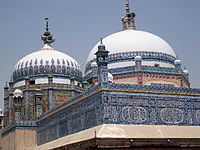Khwaja Ghulam Farid
Khawaja Ghulam Farid خواجہ غُلام فرید | |
|---|---|
 Tomb of Ghulam Farid at Mithankot | |
| Born | c. 1841/1845 Chachran, Bahawalpur, British India (present-day Punjab, Pakistan) |
| Died | 24 July 1901 (aged 56 or 60) Chachran, Bahawalpur, British India (present-day Punjab, Pakistan) |
| Resting place | Mithankot, Punjab, Pakistan |
| Notable work | Diwan-e-Farid Manaqab-e-Mehboobia Fawaid Faridia |
Khawaja Ghulam Farid (also romanized as Fareed; c. 1841/1845 – 24 July 1901) was a 19th-century Sufi poet and mystic from Bahawalpur, Punjab, British India, belonging to the Chishti Order. Most of his work is in his mother tongue Multani, or what is now known as Saraiki. However, he also contributed to the Punjabi, Urdu, Pashto, Sindhi, Hindi and Persian literature.[1][2][3][4] His writing style is characterized by the integration of themes such as death, passionate worldly and spiritual love, and the grief associated with love.[4]
Life
[edit]He was born into a branch of the Koreja family who claimed descent from Umar (r. 634–644), the second Rashidun caliph through an early migrant to Sindh. The family was established as saints associated with the Suhrawardī Sufi order. Originally from Thatta, Sindh, the family seat later moved to Mithankot in the early 18th century on the invitation of a disciple and subsequently transferred their allegiance to the Chishtī order.[2][5] Khawaja Farid was born c. 1841/1845 at Chachran. Farid's father died when he was around eight years of age. He was then brought up by his elder brother, Khawaja Fakhr al-Dīn, and grew up to become a scholar and writer. He received a fine formal education at the royal palace of Ṣādiq Muḥammad IV, the Nawab of Bahawalpur. His brother Fakhr al-Dīn, who had brought him up after their parents' deaths, also died when Farid was 26 years old. Farid performed hajj (pilgrimage to Mecca) in 1875, and then retired to the Cholistan Desert (also known as Rohi) for chilla (retreat) where he spent a total of eighteen years. He died at Chachran on 24 July, 1901, and was buried at Mithankot.[2]
Works
[edit]His most significant works include:[2]
- Dīwān-i Farīd
- Manāqib-i maḥbūbiyya (Persian prose)
- Fawāʾid-i Farīdiyya (Persian prose)
Legacy
[edit]| Part of a series on Islam Sufism |
|---|
 |
|
|
- A literary award named after Farid – the Khwaja Ghulam Farid Award – is awarded yearly by the Pakistan Academy of Letters in literature, its recipients including Ismail Ahmedani (in 2013) and Irshad Taunsvi (in 2007) among others.[6]
- Fareed Gate is the name of one of the historic gates surrounding the old city of Bahawalpur named in Farid's honour.
- The Khawaja Fareed University of Engineering and Information Technology (KFUEIT) in Rahim Yar Khan District was named after Farid.
- Shrine of Khawaja Ghulam Farid in Rajanpur, Punjab is among the 10 most visited shrines in Pakistan.[7]
See also
[edit]- Fariduddin Ganjshakar
- Punjabi literature
- Qari Muhammad Muslehuddin Siddiqui
- Pathanay Khan
- Christopher Shackle
References
[edit]- ^ Suvorova, Anna (22 July 2004). Muslim Saints of South Asia: The Eleventh to Fifteenth Centuries. Routledge Sufi Series. Routledge. p. 82. ISBN 978-1134-37005-4.
Later on these assertions became the conventional tradition of the Sufi poetry that was summed up by the Punjabi poet-mystic Khwaja Ghulam Farid (1841–1901) in one of his kāfī:
- ^ a b c d Shackle, Christopher (2013). "Ghulām Farīd". In Fleet, Kate; Krämer, Gudrun; Matringe, Denis; Nawas, John; Rowson, Everett (eds.). Encyclopaedia of Islam (3rd ed.). Brill Online. doi:10.1163/1573-3912_ei3_COM_24430. ISSN 1873-9830.
- ^ Mir, Farina (2010). The Social Space of Language: Vernacular Culture in British Colonial Punjab. South Asia across the Disciplines. Berkeley: University of California Press. pp. 105–106. ISBN 978-0-520-26269-0.
- ^ a b Langah, Nukhbah Taj (3 July 2014). "Tracing Sufi influence in the works of contemporary Siraiki Poet, Riffat Abbas". South Asian Diaspora. 6 (2). Routledge: 194. doi:10.1080/19438192.2014.912465. ISSN 1943-8192.
Khwaja Farid's writing style combines the themes of death, passionate worldly and spiritual love and grief associated with love. He wrote in various different languages including Punjabi, Urdu, Pashto, Sindhi, Hindi and Persian, but gained popularity mainly for writing in his mother language, Siraiki.
- ^ Asghar, Muhammad (2016). The Sacred and the Secular: Aesthetics in Domestic Spaces of Pakistan/Punjab. LIT Verlag Münster. p. 92. ISBN 978-3-643-90836-0.
This saint originally belonged to Thatta (Sindh), and is buried in Mithankot, a small town on the right bank of the river Indus. Khwaja Ghulam Farid (1841-1901) is the most famous Chishti Sufi saint in Pakistan and particularly revered in Southern Punjab where Seraiki language is spoken. He composed many mystical lyrics in the Seraiki language.
- ^ PAL announces National Literary Awards Academy of the Punjab in North America website, Published 10 August 2007, Retrieved 15 April 2020
- ^ Sumayia Asif (2 November 2015). "10 most visited shrines in Pakistan". The Express Tribune (newspaper). Retrieved 28 April 2022.
